Related Research Articles

Bushrangers were originally escaped convicts in the early years of the British settlement of Australia who used the bush as a refuge to hide from the authorities. By the 1820s, the term had evolved to refer to those who took up "robbery under arms" as a way of life, using the bush as their base.
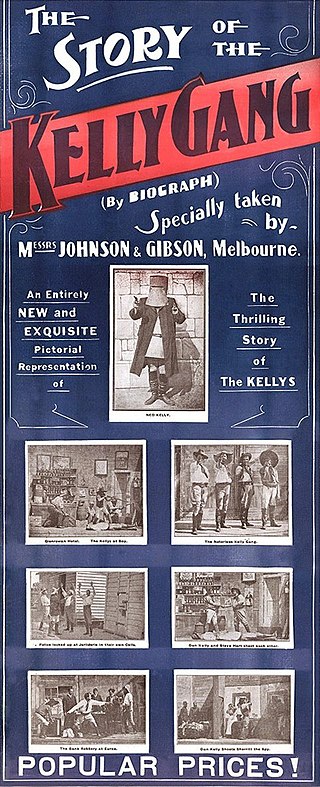
The Story of the Kelly Gang is a 1906 Australian Bushranger film directed by Charles Tait. It traces the exploits of 19th-century bushranger and outlaw Ned Kelly and his gang, with the film being shot in and around Melbourne. The original cut of this silent film ran for more than an hour with a reel length of about 1,200 metres (4,000 ft), making it the longest narrative film yet seen in the world. It premiered at Melbourne's Athenaeum Hall on 26 December 1906 and was first shown in the United Kingdom in January 1908. A commercial and critical success, it is regarded as the origin point of the bushranging drama, a genre that dominated the early years of Australian film production. Since its release, many other films have been made about the Kelly legend.

Daniel Morgan was an Australian bushranger. Morgan has been described as "the most bloodthirsty ruffian that ever took to the bush in Australia" and “one of the most determined and bloodthirsty of colonial freebooters”. Many accounts of his activities, particularly in the years after his death, emphasise his brutality and erratic behaviour but Morgan had many sympathisers and informants in the districts where he carried out his activities. He was an expert bushman with superb horse-riding skills, a combination of abilities which enabled him to evade capture by the authorities for a significant period of time.

Thomas Alexander Browne was an Australian author who published many of his works under the pseudonym Rolf Boldrewood. He is best known for his 1882 bushranging novel Robbery Under Arms.

Robbery Under Arms is a bushranger novel by Thomas Alexander Browne, published under his pen name Rolf Boldrewood. It was first published in serialised form by The Sydney Mail between July 1882 and August 1883, then in three volumes in London in 1888. It was abridged into a single volume in 1889 as part of Macmillan's one-volume Colonial Library series and has not been out of print since.
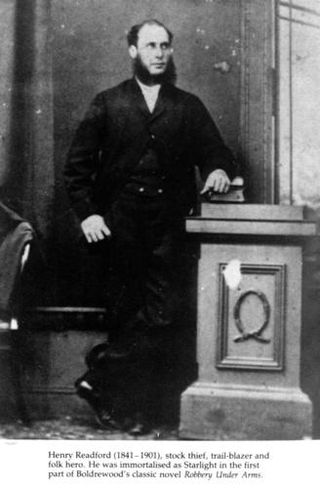
Henry Arthur Readford, was an Australian stockman, drover and cattle thief.

Robbery Under Arms is a 1920 Australian film directed by Kenneth Brampton and financed by mining magnate Pearson Tewksbury. It is an early example of the "Meat pie Western".
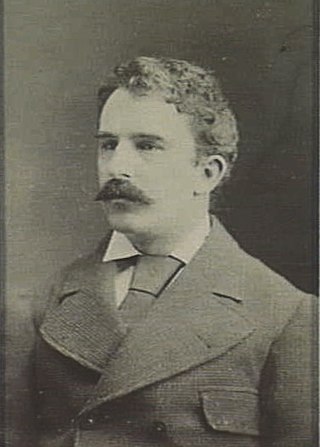
Alfred Dampier was an English-born actor-manager and playwright, active in Australia.

Robbery Under Arms is a 1985 Australian action adventure film starring Sam Neill as bushranger Captain Starlight.
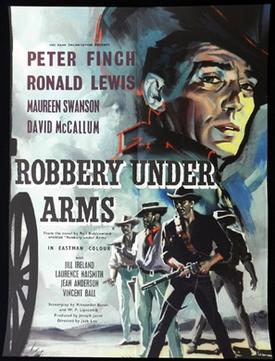
Robbery Under Arms is a 1957 British crime film directed by Jack Lee and starring Peter Finch and Ronald Lewis. It is based on the 1888 Australian novel Robbery Under Arms by Thomas Alexander Browne who wrote under the pseudonym Rolf Boldrewood.

Alfred Rolfe, real name Alfred Roker, was an Australian stage and film director and actor, best known for being the son-in-law of the celebrated actor-manager Alfred Dampier, with whom he appeared frequently on stage, and for his prolific output as a director during Australia's silent era, including Captain Midnight, the Bush King (1911), Captain Starlight, or Gentleman of the Road (1911) and The Hero of the Dardanelles (1915). Only one of his films as director survives today.
Robbery Under Arms is a 1907 Australian silent western/drama film based on the 1888 novel by Rolf Boldrewood about two brothers and their relationship with the bushranger Captain Starlight. It was the first film version of the novel and the third Australian feature ever made.
Charles Cozens Spencer was a British-born film exhibitor and producer, who was a significant figure in the early years of the Australian film industry. He produced films under the name Spencer's Pictures and was an early backer of the films of Raymond Longford. He was also instrumental in the creation of "The Combine".
Captain Starlight, or Gentleman of the Road is a 1911 Australian silent film about the bushranger Captain Starlight. It was based on Alfred Dampier's stage adaptation of the 1888 novel Robbery Under Arms. It is considered a lost film.

Henry Albert ('Bert') Forsyth, known professionally as H. A. Forsyth, was a pioneer of Australian film production during the silent era. From about 1907 to 1909 Forsyth worked as a travelling picture showman, screening the film Robbery Under Arms in Australian country towns. In 1910 his company, Southern Cross Motion Pictures, produced and released two successful motion pictures, Thunderbolt and Moonlite, based on incidents in the careers of the bushrangers Frederick Ward and Andrew Scott. For these projects Forsyth worked with Jack Gavin, who directed both films and acted in the lead roles. In January 1913 the New South Wales Government banned Forsyth's bushranger films. At various stages in his career Bert Forsyth also managed theatres that screened motion pictures.
The bushranger ban was a ban on films about bushrangers that came in effect in Australia in 1911–12. Films about bushrangers had been the most popular genre of local films ever since The Story of the Kelly Gang (1906). Governments were worried about the influence this would have on the population and bans against films depicting bushrangers were introduced in South Australia (1911), New South Wales and Victoria (1912).
Robbery Under Arms is a 1950 BBC radio adaptation of Rolf Boldrewood's popular 1888 novel Robbery Under Arms.

Edward Irham Cole was an Australian theatrical entrepreneur and film director whose productions represented a synthesis of Wild West show and stage melodrama. He managed a theatre company, called the Bohemian Dramatic Company, that performed in semi-permanent and temporary tent theatres. During 1910 and 1911 Cole directed a number of silent films, adapted from his stage plays and using actors from his theatre company.
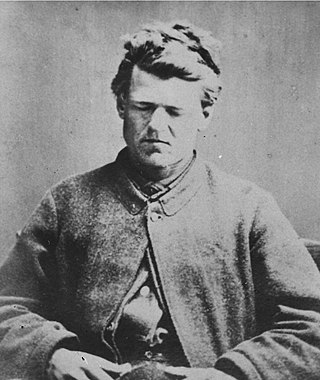
Bluecap was an Australian bushranger. Born and raised in New South Wales, he began bushranging in 1867, leading a gang responsible for robberies throughout the Riverina region. He suffered from ophthalmia, and earned his alias on account of a piece of cloth he wore to protect his eyes from sunlight. Captured in November 1867, Bluecap was tried and convicted of armed robbery. He was imprisoned in Parramatta Gaol and released in 1874.
Robbery Under Arms is a 1890 play by Alfred Dampier and Garnet Walch based on the novel of the same name by Rolf Boldrewood.
References
- ↑ "Advertising". Melbourne Punch . 31 October 1907. p. 27. Retrieved 18 June 2015– via National Library of Australia.
- ↑ "ENGAGEMENT". Melbourne Punch . 31 October 1907. p. 27. Retrieved 18 June 2015– via National Library of Australia.
- ↑ "Greenroom Gossip". Melbourne Punch . 10 October 1907. p. 34. Retrieved 18 June 2015– via National Library of Australia.
- ↑ ""Robbery under Arms."". Table Talk . Melbourne. 7 November 1907. p. 24. Retrieved 18 June 2015– via National Library of Australia.
- ↑ "Film Year Book: The 1922-23 Film Daily Year Book of Motion Pictures" p 171. Retrieved 24 June 2015
- ↑ ""ROBBERY UNDER ARMS."". The West Australian . Perth. 24 December 1907. p. 9. Retrieved 18 June 2015– via National Library of Australia.
- ↑ "PICTURE PROFILES IN THE OLDEN DAYS". Winner . Melbourne. 9 February 1916. p. 11. Retrieved 18 June 2015– via National Library of Australia.
- ↑ W Gibson obituary which refers to film
- ↑ ""ROBBERY UNDER ARMS."". The Telegraph . Brisbane. 11 February 1908. p. 5. Retrieved 20 June 2015– via National Library of Australia.
- ↑ Robbery Under Arms (advertisement), Wagga Wagga Advertiser, 7 January 1908, page 3.
- ↑ "Music and the Drama". The Examiner (DAILY ed.). Launceston, Tasmania. 11 October 1907. p. 2. Retrieved 18 June 2015– via National Library of Australia.